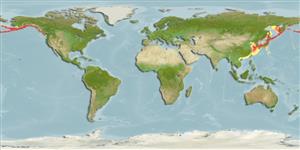Environment: milieu / climate zone / depth range / distribution range
Ökologie
seewasser demersal; tiefenbereich 0 - 604 m (Ref. 50550). Temperate; 66°N -
North Pacific: Hokkaido, Japan to the Bering Sea.
Length at first maturity / Size / Gewicht / Alter
Maturity: Lm 26.0, range 24 - 28 cm
Max length : 36.0 cm SL Männchen/unbestimmt; (Ref. 559); common length : 27.0 cm TL Männchen/unbestimmt; (Ref. 56557); max. veröff. Gewicht: 800.00 g (Ref. 56557); max. veröff. Alter: 12 Jahre (Ref. 56557)
Kurzbeschreibung
Morphologie | Morphometrie
Rückenflossenstacheln (insgesamt): 11 - 12; Rückenflossenweichstrahlen (insgesamt): 20-22; Afterflossenstacheln 0; Afterflossenweichstrahlen: 14 - 19. Three zonal scale rows on body; a scale row of small ctenoid scales under the ventral scale row (Ref. 559). Four preopercular spines, the 2nd longest and simple, the 4th flattened; the first dorsal spine longer than the 2nd (Ref. 559).
Oviparous. Non-copulatory. However according to one study, presence of fertilized eggs in the ovary may have resulted from spermatozoa entering the ovary through the ovarian fluid during spawning, and consequently fertilizing unspawned eggs in the ovaries (Ref. 47168). Fertilized eggs in the ovary develop abnormally however, due to the unavailability of needed elements such as oxygen in the ovary (Ref. 47168).
Masuda, H., K. Amaoka, C. Araga, T. Uyeno and T. Yoshino, 1984. The fishes of the Japanese Archipelago. Vol. 1. Tokai University Press, Tokyo, Japan. 437 p. (text). (Ref. 559)
IUCN Rote Liste Status (Ref. 130435)
Bedrohung für Menschen
Harmless
Nutzung durch Menschen
Mehr Information
ReferenzenAquakulturAquakultur ProfilZuchtlinienGenetikElectrophoresesVererbbarkeitKrankheitenVerarbeitungNutrientsMass conversion
PartnerBilderStamps, Coins Misc.LauteCiguateraGeschwindigkeitSchwimmstilKiemenoberflächeOtolithsGehirngrößeSehfähigkeit
Tools
Zusatzinformationen
Download XML
Internet Quellen
Estimates based on models
Preferred temperature (Ref.
123201): 0.7 - 14.7, mean 3.9 °C (based on 374 cells).
Phylogenetic diversity index (Ref.
82804): PD
50 = 0.5156 [Uniqueness, from 0.5 = low to 2.0 = high].
Bayesian length-weight: a=0.00676 (0.00300 - 0.01523), b=3.17 (2.98 - 3.36), in cm total length, based on LWR estimates for this (Sub)family-body shape (Ref.
93245).
Trophic level (Ref.
69278): 3.6 ±0.1 se; based on diet studies.
Widerstandsfähigkeit (Ref.
120179): niedrig, Verdopplung der Population dauert 4,5 - 14 Jahre. (tm = 5-6).
Fishing Vulnerability (Ref.
59153): Low to moderate vulnerability (34 of 100).
